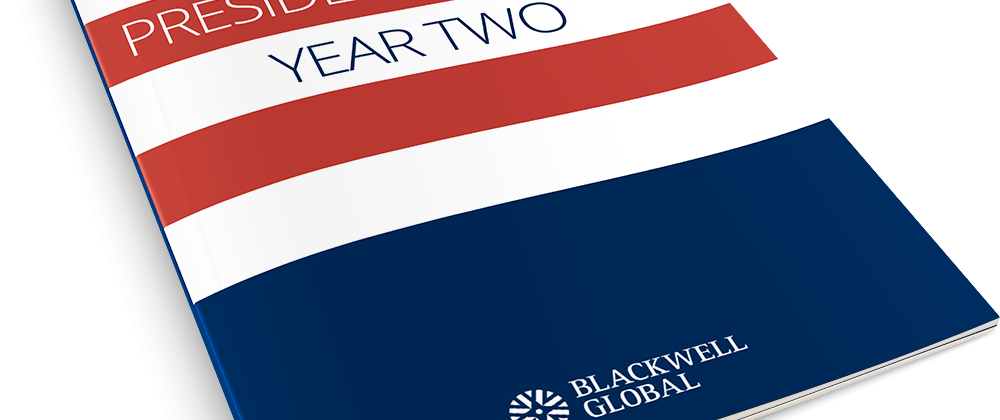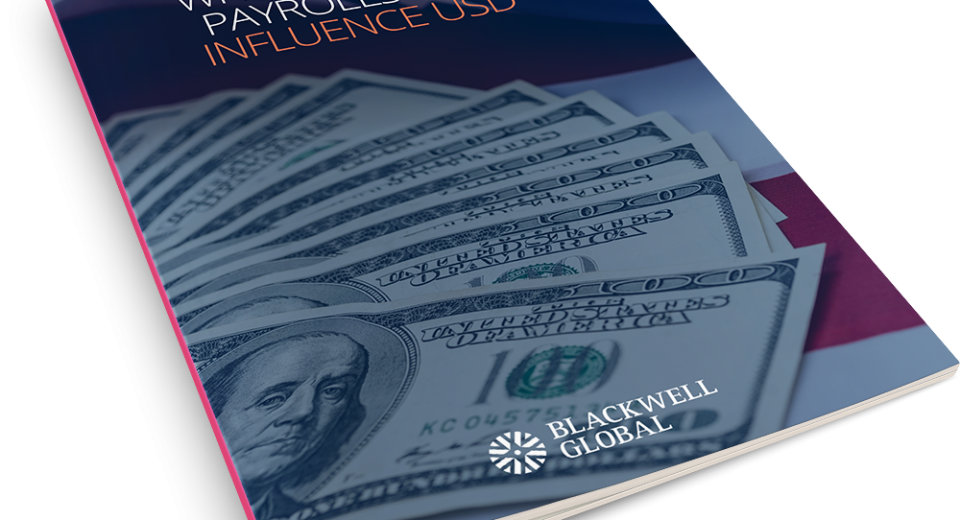President Trump: Year Two Ebook

THE LAY OF THE LAND
SUMMARISING 2017
Needless to say, 2017 was a very memorable year. President Trump’s first 365 days in office have been like no other. His tenure could be described as many things – but certainly not boring.
Much of the media’s focus has centred on Trump’s unorthodox approach to the presidency. The coverage has been relentless, analysing everything from controversial tweets to awkward handshakes with other world leaders.
However, there have been some interesting policy developments too. This includes the failed attempt at repealing ‘Obamacare’, abandoning the Paris accord and passing tax reform.
All of the above has affected the financial markets.
For instance, we’ve seen US stock markets break multiple records throughout 2017, while the US dollar has weakened against other major currencies (often a temporary barometer for market sentiment for all things US).
All the while, the US economy remains strong. Growth is steady and unemployment remains low. Trump’s actions have done nothing to dampen the economic bounce inherited from the Obama administration. In fact, some would argue they have added momentum.
So can we expect more of the same in 2018? Quite possibly. In the following sections, we’ve listed the ‘big issues’ that are likely to define his second year in office.
THE BIG ISSUES FOR 2018
THE MUELLER INVESTIGATION
Special Counsel Robert Mueller is currently conducting an investigation into whether the Trump campaign colluded with Russia in order to win the presidency in 2016.
It’s a topic the US media has rigorously pursued since President Trump’s election victory.
Make no mistake, this investigation has the potential to shake the foundations, if not end, this presidency. We’ve already seen four Trump campaign associates criminally charged in 2017.
The individuals charged include: Mike Flynn, Paul Manafort, Rick Gates and George Papadopoulos.
In the case of Mike Flynn – the former National Security Adviser in the Trump administration – Mueller has secured ‘witness cooperation’. Usually, this involves a person guilty of a crime sharing incriminating evidence in return for a lighter charge.
With this in mind, it seems as though Mueller and his team are building an ‘Obstruction Of Justice’ case against President Trump’s closest advisers, including Jared Kushner, Jeff Sessions and Don Trump Jr. The president himself could also be a target.
The ‘Obstruction Of Justice’ case relates to the White House’s alleged attempts to disrupt the FBI’s own Russia investigation in 2017 – which ultimately resulted in President Trump firing FBI Director James Comey.
At the time of writing (January 2018), we know that the president is set to be interviewed by Mueller’s investigation team in the near future. This will be a very significant moment in the Mueller investigation.
Of course, it’s impossible to pre-empt the outcome of this investigation, but there are clearly echoes of ‘Watergate’ here. If the investigation leads to serious charges being brought against President Trump or any of his senior aides, we can expect high volatility in the financial markets.
PARTISAN POLITICS
Another pressing issue for the Trump administration is turning policy ideas into legislation. Over the course of 2017, we’ve seen various bills fail to get through the House and Senate (despite both being controlled by Republicans).
The first example of this involved health care. During his campaign, President Trump promised to repeal and replace the Affordable Care Act (also known as Obamacare). Once in office, this became the first legislative priority of his administration. Ultimately, attempts to replace Obamacare with an alternative plan (called the American Health Care Act) failed.
Democrats opposed the plan, as they were concerned that it could leave millions of Americans without health care coverage. Meanwhile, some Republicans felt the proposals didn’t go far enough in removing the federal government from health care provision.
Health care is indicative of the political divide that exists in Washington today. That’s why the White House will continue to find it difficult to pass controversial bills in the House and Senate.
In fact, we’ve already seen these differences lead to political deadlock in early 2018. Disagreements between the Democrats, Republicans and the White House over immigration reform has already led to a government shutdown (which lasted two days).
At the time of writing (January 2018), immigration policy is still unresolved. Democrats want safeguards put into place for the so-called ‘Dreamers’ (children of illegal immigrants born in the US), while Republicans want to secure funding for the proposed southern border wall.
Considering the profound disagreement between the two parties on immigration reform, there’s certainly a chance of another government shutdown in early February 2018.
The ability of the Trump administration to turn policy proposals into legislation matters to the financial markets because it can affect investor confidence. For example, on the back of Trump’s election victory, we saw a huge sell-off of global bonds in favour of private equities. Much of this was fuelled by Trump’s pledge to implement a $1 trillion infrastructure plan in the US and cut corporate tax rates.
Clearly, should the Trump administration fail to deliver on the promises that excited investors, sentiment will quickly change.
MID-TERM ELECTIONS
The year ahead includes President Trump’s first electoral test. There’s a whole host of political positions being contested this year – including seats in the House of Representatives and Senate.
Clearly, the results of these elections will give us a picture of the electorate’s satisfaction with the Trump administration. But more importantly, they have the potential to change which party controls the House and Senate.
As previously mentioned, the White House is already finding it difficult to see its policy ideas come to fruition – despite its own party (the Republicans) controlling both the House and Senate. If Democrats ended up controlling either one of those chambers, political gridlock on President Trump’s controversial policy ideas would follow.
Moreover, if Democrats have control of either the House or Senate, they would be able to sanction further investigations into the Trump campaign’s alleged collusion with Russia. Currently, both the House and Senate are running their own investigations into Russian interference in the US Presidential Election. But as Republicans control both chambers – they are less inclined to scrutinise their party’s incumbent president.
It’s difficult to determine how the mid-term elections will play out. Trump’s approval rating has consistently polled in the mid-thirties for the last few months, which is historically low for a president entering his second year in office. This would suggest that Republican seat losses are a real possibility.
But it’s important to recognise that local issues can also determine electoral results. That’s why predicting election outcomes is a complex business.
Regardless, as a trader, you should be aware of how the legislative agenda of the US government could change if the Democrats gain control of either chamber, as political gridlock would only hamper investor confidence.
CHANGES AT THE FED
TRUMP CAN SHAPE THE FED
The aforementioned issues could affect President Trump’s ability to shape fiscal policy (government spending and taxation). But 2018 will also give the president an opportunity to influence monetary policy (controlled by the Federal Reserve).
He can do this through nominations for vacant positions in the Board of Governors. In fact, President Trump will have appointed six of the seven board members by the end of 2018.
This process has already started. In February, Jerome Powell (President Trump’s nominee) will replace Janet Yellen as Fed chair.
It’s well known that the president was unlikely to extend Janet Yellen’s term as Fed chair. Yellen played a key role in passing legislation that tightened bank regulation after the global financial crisis – a move which Trump and some Republicans believe hampered US financial services.
Trump has also yet to nominate a Fed vice chair, following the resignation of Stanley Fischer in October 2017.
POLICY CHANGES?
Clearly, President Trump has the opportunity to appoint Fed board members that are sympathetic to his monetary policy views.
However, his appointments so far have been viewed as a continuation of the ‘status quo’. That’s to say that most commentators expect the new look Fed to continue on the path set by their predecessors. It’s why Powell was confirmed by the Senate as a suitable replacement for Yellen by a healthy majority.
Despite this, some important distinctions have been made between Jerome Powell and Janet Yellen. For example, it’s believed Powell is in favour of lighter banking regulation – a position which President Trump favours.
WHY IT MATTERS
The monetary policy of the Fed is vital to the financial markets. This is especially true for Forex traders, as adjustments in benchmark interest rates can have a noticeable impact on economic growth and the supply and demand of capital. These dynamics can impact the value of the US dollar.
As most traders know, the Fed is currently in a ‘hiking cycle’. This has seen the Fed raise interest rates on four separate occasions since December 2016. What’s more, three further gradual rate hikes are forecast for 2018. Most commentators expect the new
PROSPECTS FOR THE US DOLLAR
MORE WEAKNESS?
The US dollar is on course for its worst January since 1987. This is in stark contrast to one year ago when the newly elected President Trump expressed concerns over the strength of the greenback.
So what’s happened to the US dollar – and what are its prospects during President Trump’s second year in office?
First of all, let’s take stock. The US dollar fell by almost 10% over the course of 2017. But why did this happen? At first glance, the answer isn’t that obvious. For instance, the Federal Reserve is currently in ‘hiking cycle’, while the US economy is continuing to grow at an impressive rate. Plus, we saw significant tax reform passed at the end of the year. On the face of it, these factors would seemingly add strength to the dollar.
However, in reality, the interest rate hikes actioned by the Federal Reserve have been deliberately small (0.25% each time). It’s widely accepted that lower than expected inflation has forced the Federal Reserve to raise rates gradually.
THE GLOBAL ECONOMIC RECOVERY
But low inflation isn’t the primary reason why the US dollar has weakened of late.
A weaker greenback is actually a symptom of the strengthening global economic recovery. After the global financial crisis of 2008, the US was the first major economy to return to growth. Other major economies are now starting to catch up.
This is why we’re seeing other major currencies appreciate against the US dollar.
The euro is a good example of this. By some distance, the eurozone recorded its strongest economic performance in 2017. Many expect this trend to continue into 2018, which will likely contribute to further US dollar weakness.
We’ve also seen the British pound hit pre-Brexit vote levels (above $1.40) against the US dollar in early 2018. The market has clearly found relief in the fact Brexit negotiations are moving onto ‘Phase 2’.
TRADE
President Trump’s administration has also proven it can have a noticeable impact on the US dollar in 2018.
In January, Steve Mnuchin (Treasury Secretary) caused a sell-off in the dollar. He stated that a weaker dollar would be beneficial for US exports. This raised questions about what stance the Trump administration favours in regards to US dollar strength. After those comments were made, President Trump did clarify that he favoured a strong US economy and dollar.
This scenario demonstrates why the markets now care about the US government’s trade policy. It’s known that the administration wants to address bilateral trade deficits with other countries. By ‘talking down’ the US dollar, officials like Mnuchin can help reduce those trade deficits (a weaker dollar makes it cheaper to export goods, and more expensive to import goods).
Clearly, it’s important that traders carefully watch the rhetoric coming from the US government in relation to trade. It very well could be a deliberate attempt to weaken the US dollar to reduce bilateral trade deficits.
look Fed to maintain this programme of tightening monetary policy in light of a strong US economy.
One metric the new Fed chair will be monitoring closely is inflation. Despite strong economic growth in recent years, inflation (the increase in the costs of goods and services) has remained low. However, this could change in the near future because of President Trump’s inflationary stimulus proposals (his $1 trillion infrastructure plan) – and a very healthy US economy.
It will be interesting to see how Jerome Powell and the remaining members of the Board of Governors would react to such a scenario.
The most likely outcome would be an aggressive increase in interest rates, which would act to taper high inflation. Such a move would act as a ‘brake’ on the US economy. It’s a scenario traders need to be aware of as we move through 2018.




